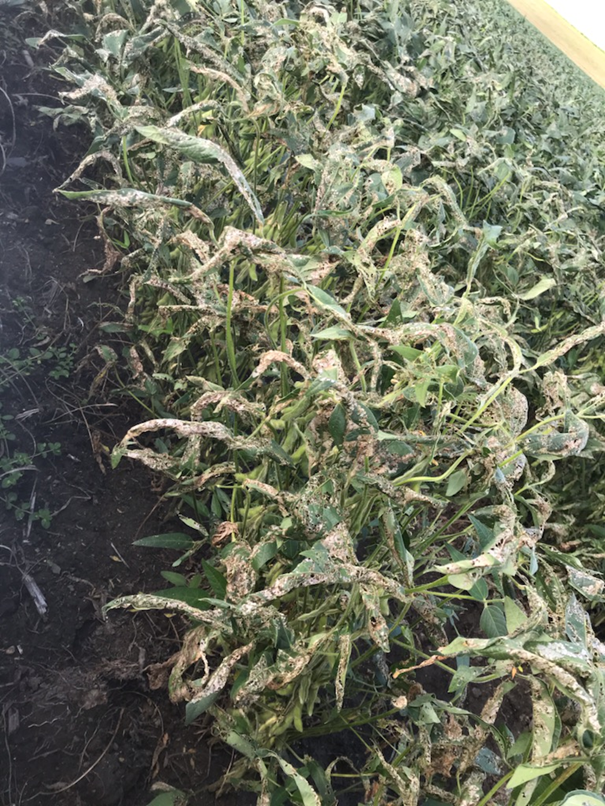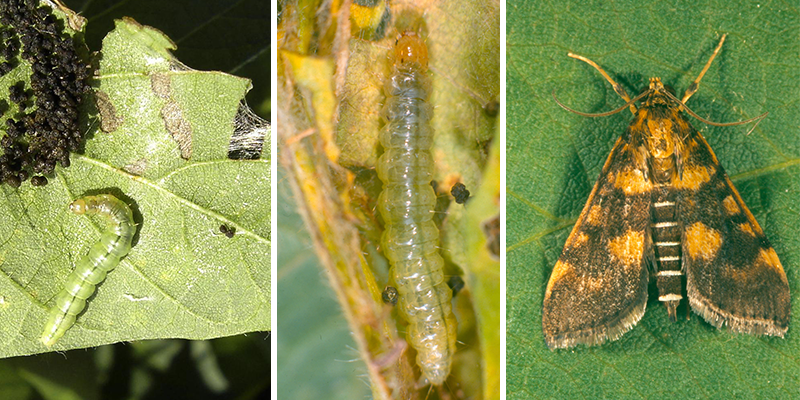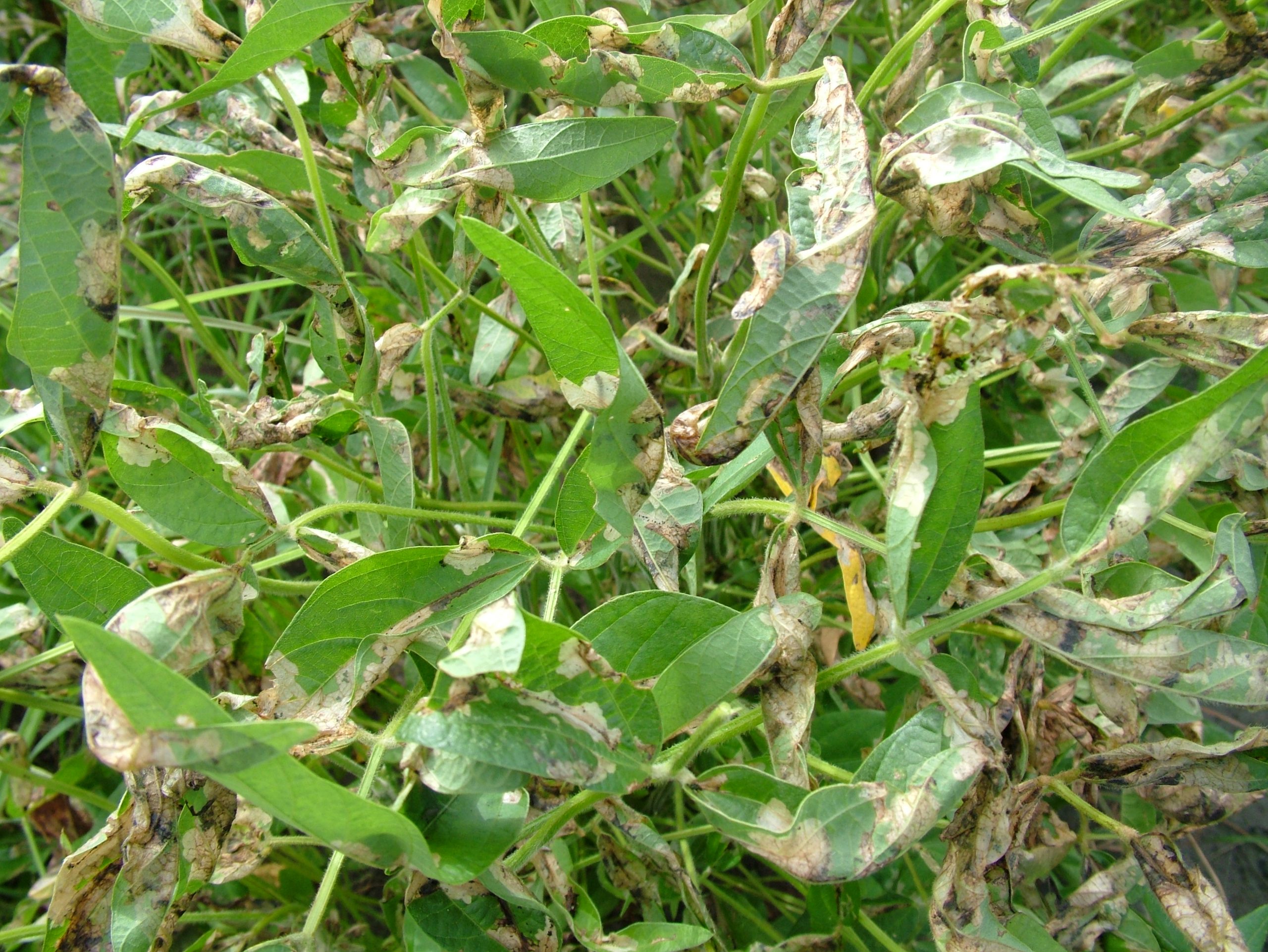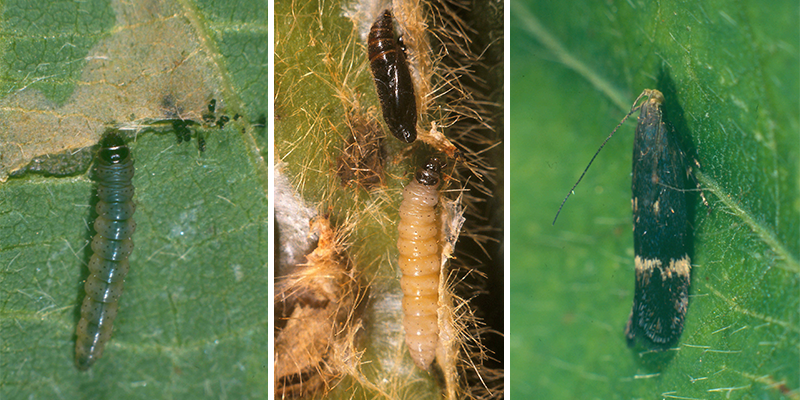As we enter the business end of the season, we want our soybean crop’s leaves to be a healthy green, as the healthier the leaves, the more the pods fill and the higher the yield. In a drought year, dryland crops turn brown prematurely due to lack of water, but in wet years or in irrigated crops, leaves should not be turning brown until pods mature. If your crop is browning prematurely, check it as soon as possible for diseases (such as target spot or anthracnose) and insect pests (such as soybean moth and legume webspinners). This blog article covers insect pests; a complementary blog will cover the leaf-browning diseases.
Legume webspinner

Severe webspinner damage (photo by Daniel Gonzalez)
A recent example was in a crop near Mackay, where despite recent heavy rain, the crop still turned brown. Closer inspection revealed the culprit as legume webspinner. Webspinner larvae web leaves together and feed within them. The sticky webbing catches the poo (frass) made by feeding larvae. Although common in coastal and tropical soybean crops, in most years this pest does not reach such high densities. Soybeans can tolerate significant defoliation (as high as 33%) during the vegetative stages, but this decreases to 16-20% during podfill.
To avoid being caught out by damaging populations, check crops weekly during the vegetative stages and twice weekly during the podfill stage. Intensive scouting allows you to pick up the early stages of infestations, including flights of the distinctive yellow and brown moths followed by the small pale green larvae feeding in folded leaves. As larvae grow, they damage more leaf material until, in severe infestations (as in this crop), a high percentage of leaf tissue is destroyed.

Legume webspinner stages: larva and frass, large larva (14 mm), and moth (13 mm wingspan)
In crops where outbreaks are not detected early, check that larvae are still feeding (are not in the prepupal or pupal stages). Larvae close to pupation have already inflicted most of their damage and the economic benefits of late spraying are debatable.
Soybean moth

Soybean moth leaf mines in a heavily infested crop
The other most common but sporadic soybean leaf mining pest is soybean moth. These larvae are much smaller (5 mm) and are a grey green with a dark head. They feed initially inside the leaves in small leaf mines which grow progressively larger as larvae grow. In severe infestations, there are multiple leaf mines per leaf, and in extreme cases, the mines can merge, giving total defoliation. Again, early scouting will detect the small distinctive moths, black with a white transverse band, and early leaf mines with small larvae. If the larvae are white, they are nearing pupation and have stopped feeding, and spraying is a waste of time. As for webspinners, soybean moth thresholds are based on percentage defoliation (33% during the vegetative stages and 16-20% during pod set and podfill).

Soybean moth stages: larva (5 mm); prepupal non feeding larva (white) and pupa; adult moth (6 mm long)
Control options
Soybean moth larvae are easily controlled with abamectin at 300 mL/ha under Permit PER86185 (valid until 30 April 2023). This product is effective because it has translaminar activity (is able to penetrate the leaves to kill the larvae within). Insecticides without translaminar activity such as methomyl and synthetic pyrethroids (e.g. deltamethrin, alpha-cypermethrin) will give very poor control of soybean moth larvae.
Soybean moth larvae killed by abamectin turn an opaque grey colour, however larvae in the pale (white) pre-pupal stage have stopped feeding and will not be controlled by the insecticide. Remember that abamectin has a lengthy 28-day withholding period. Note also that contrary to expectations, abamectin has been ineffective against legume webspinner in recent DAF trials.
Most legume webspinners had pupated in the Mackay crop illustrated above and the optimal time to spray (for this webspinner outbreak) was therefore long gone. However, the majority of larvae that were still present showed clear sickness symptoms (shrunken and not as active) following a chlorantraniliprole (Altacor®) spray applied for helicovera.
Please inspect your soybean crops diligently and report the early stages of any severe infestations so that DAF can work towards securing an emergency permit for legume webspinner.
The probability of outbreaks of pests such as legume webspinner occurring can be reduced by the judicious use of pesticides when managing other pests by:
- only spraying above-threshold pest populations,
- using the softest options where appropriate, e.g. viral biopesticides (e.g. VivusMax) for helicoverpa in vegetative soybeans, and
- delaying the use of hard non-selective insecticides as long as possible, i.e. ‘Go Soft Early’.
A prime example of the latter strategy is for podsucking bugs (PSB) for which there are currently no effective ‘soft’ (low impact on beneficials) insecticides. For PSB, the only IPM strategy is to delay spraying, as PSB don’t inflict economic damage before podfill. If adopted on an area-wide basis, the above approaches will foster populations of beneficial insects, to the detriment of pests.
Article by Hugh Brier and Daniel Gonzalez DAF Kingaroy and Mackay.
Unless otherwise noted, all photos by Hugh Brier (DAF) and Joe Wessels (ex DAF).
